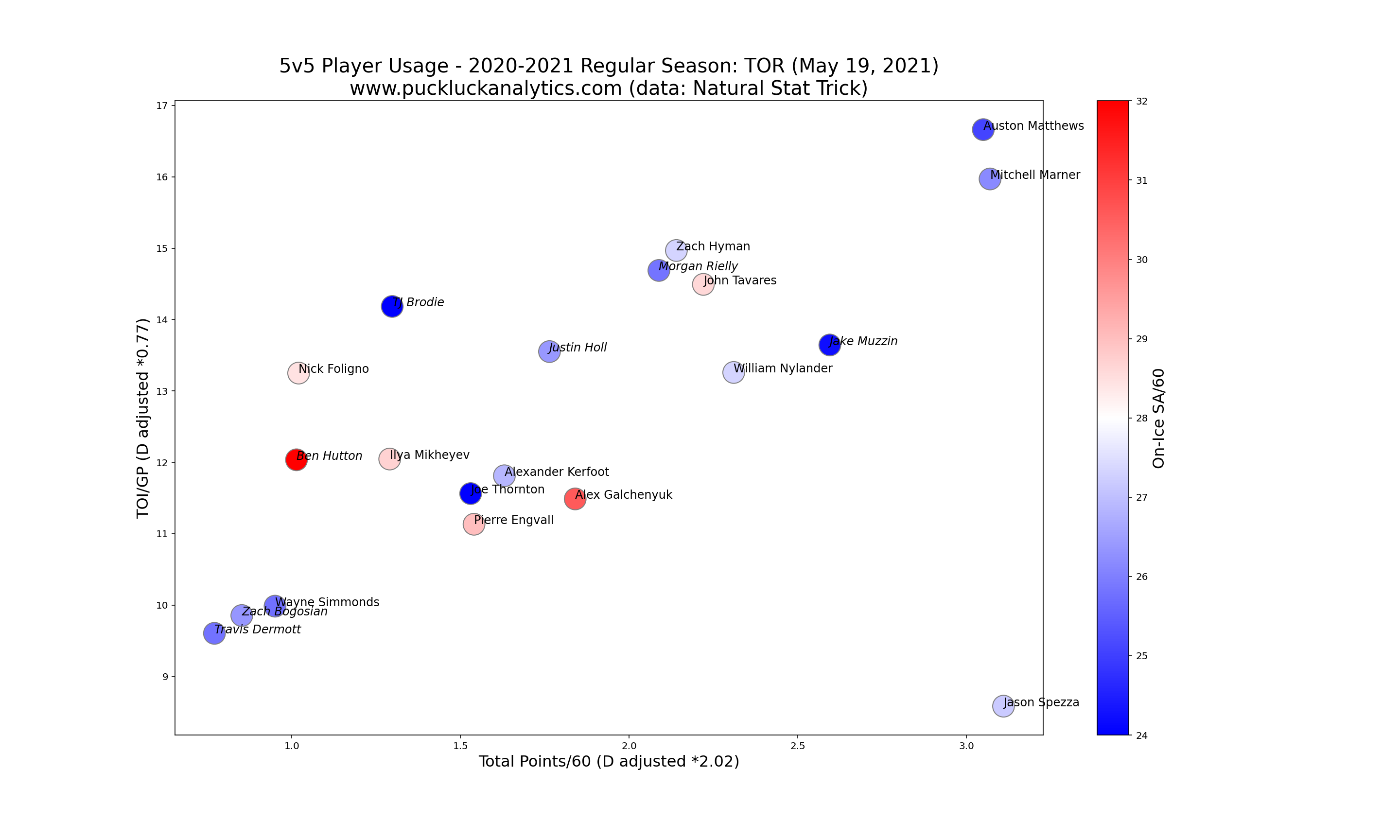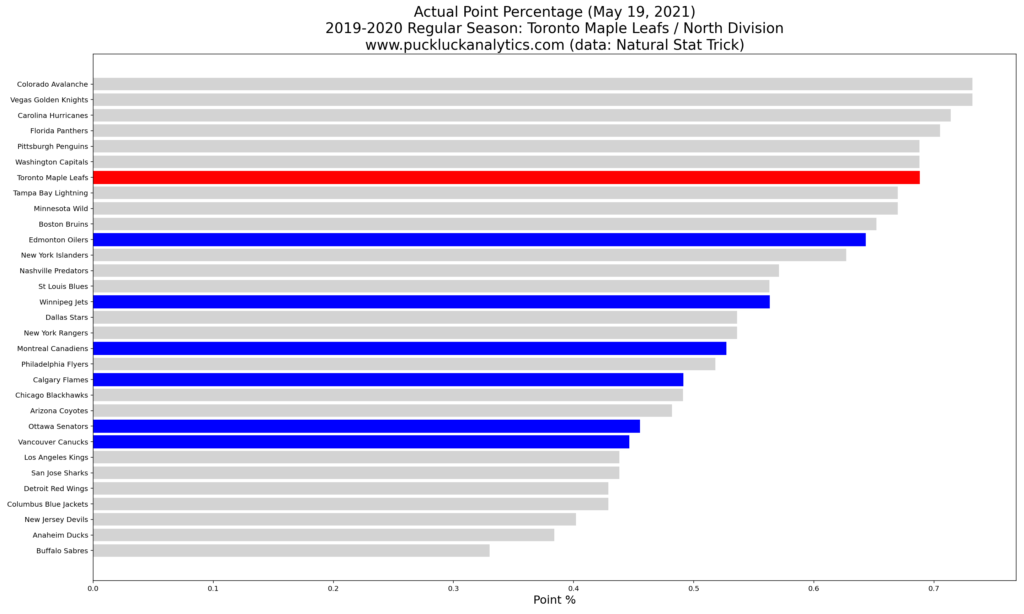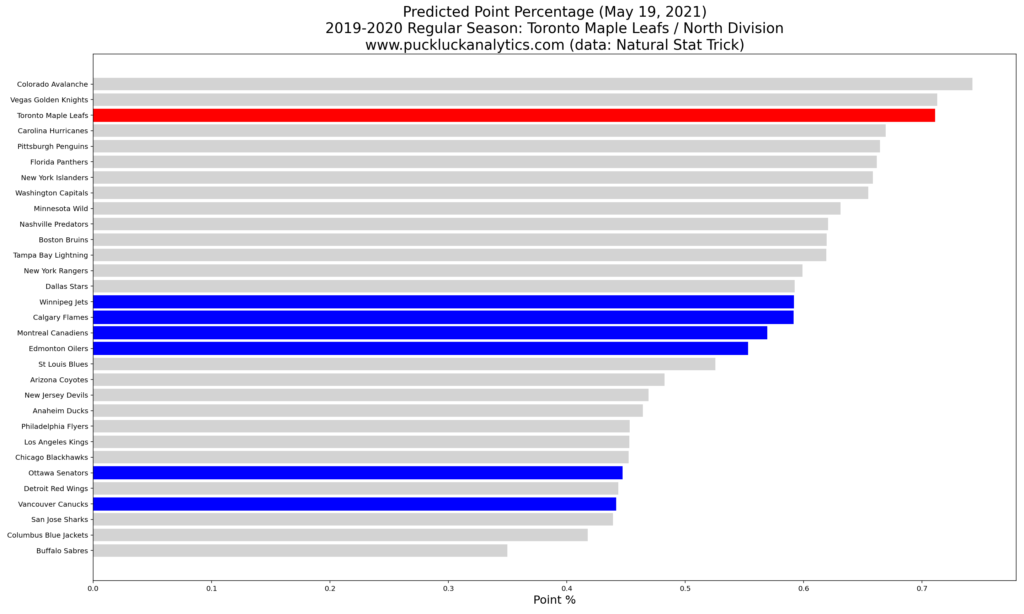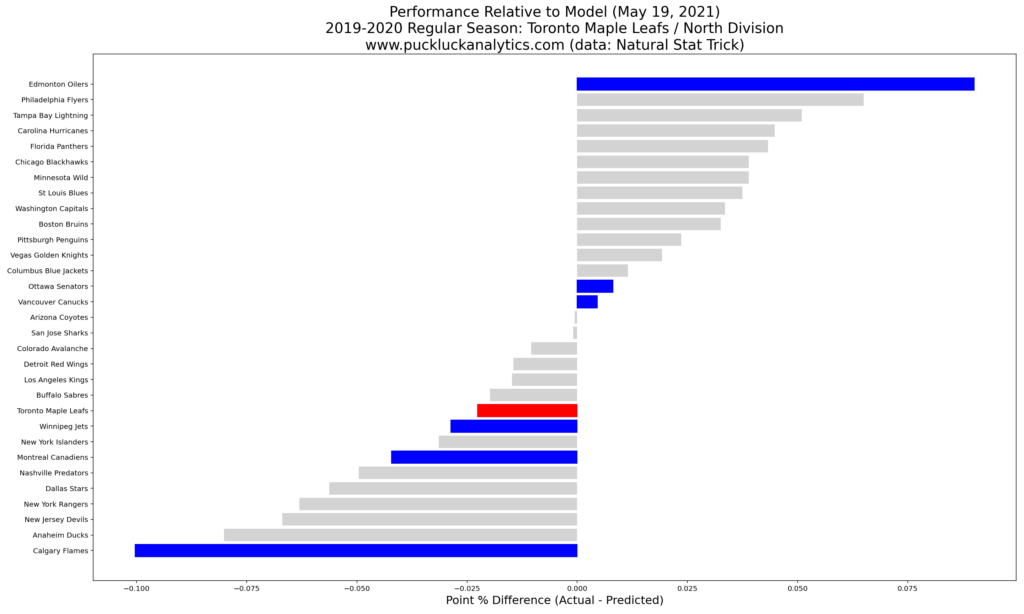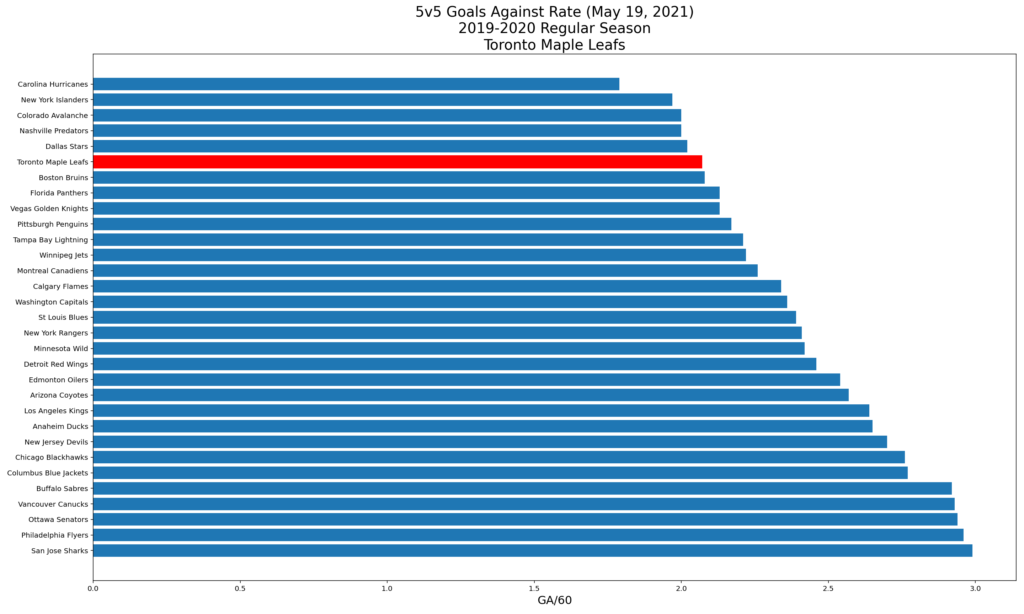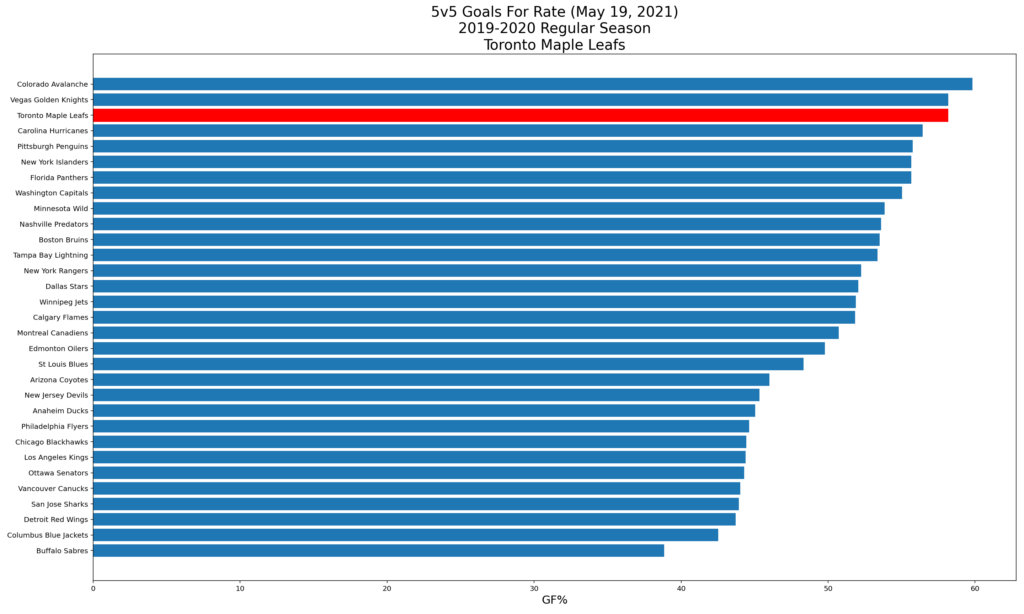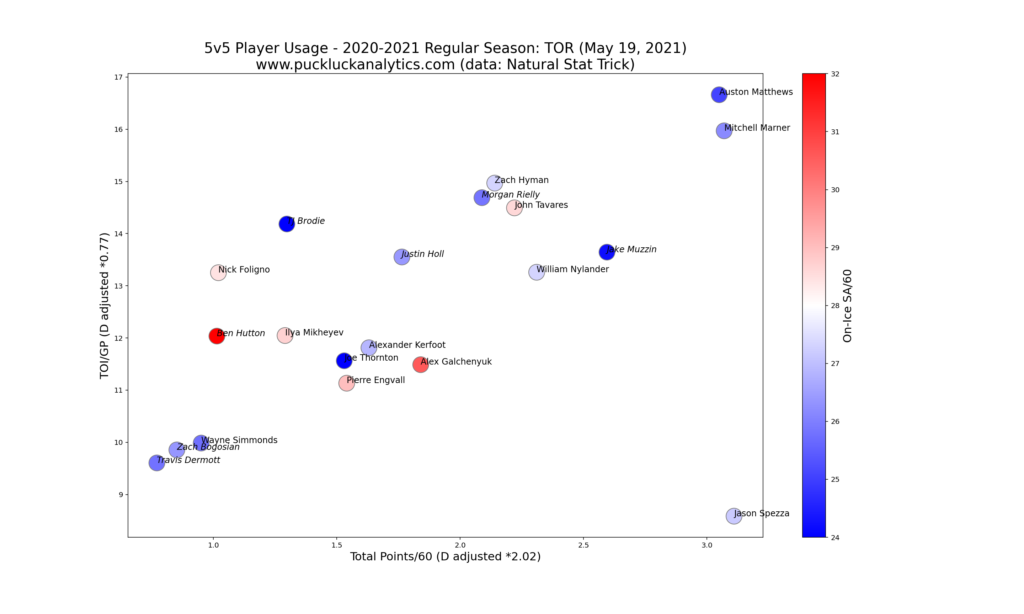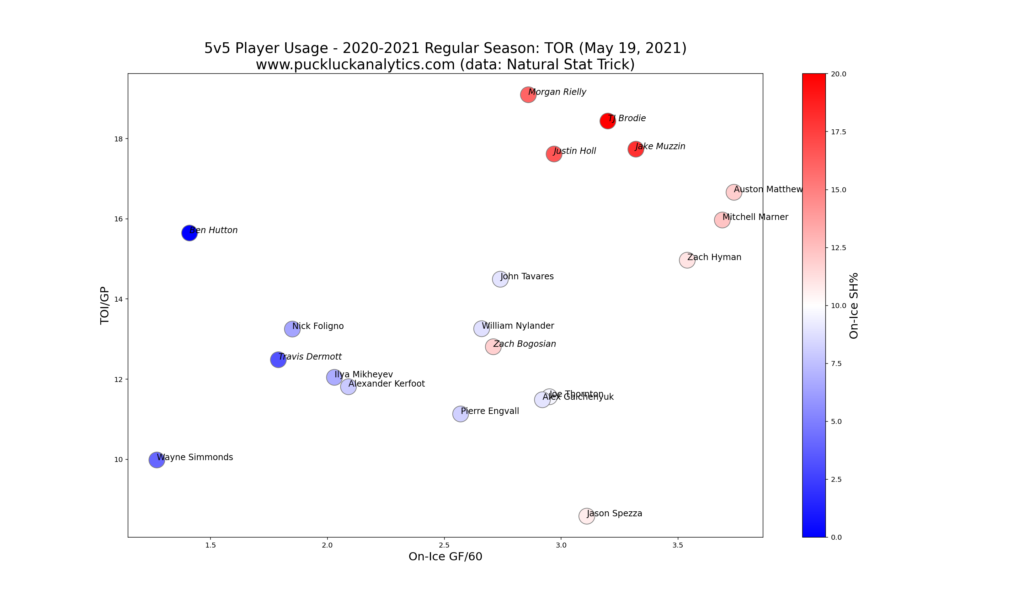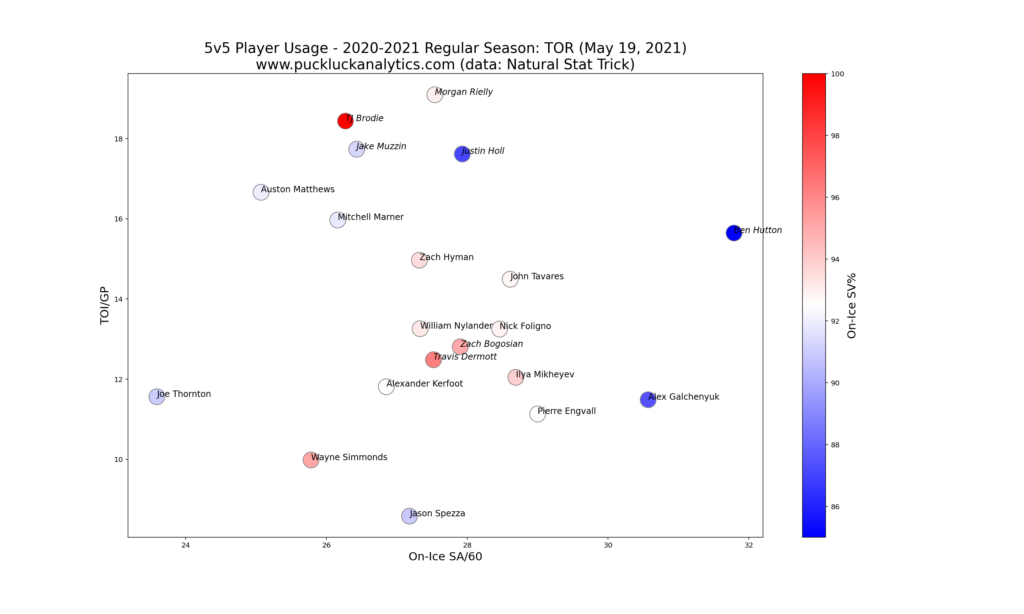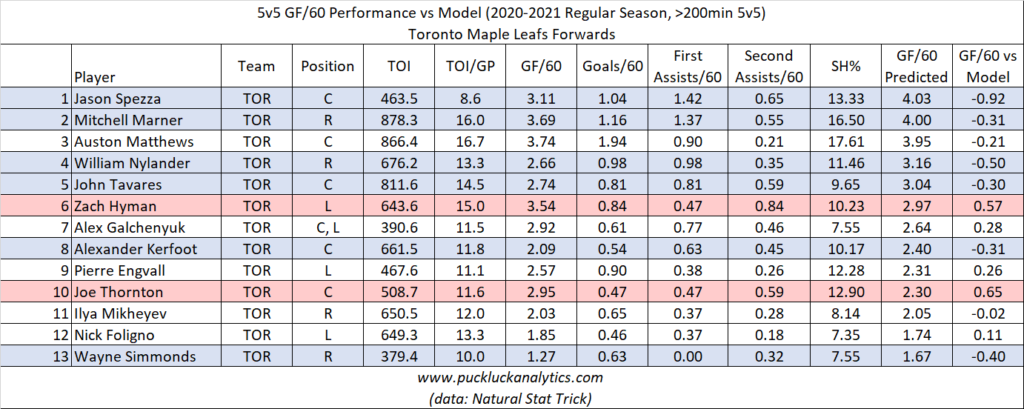The Toronto Maple Leafs were expected to be a contender this season, getting away from first round matchups with the Lightning and Bruins due to the divisional realignment. After yet another disappointing first round exit, the Leafs are left looking for answers. Let’s dig into their season and see if we can find some. If you haven’t already, I recommend checking out this post that has some additional detail on the plots we’ll look at in our review.
Overall Performance (Regular Season)
The Maple Leafs were the class of the North Division during the regular season, easily walking into the playoffs as the top seed. Using our points predictor model that uses 5v5 data as input, let’s take a look at how they stacked up at even strength.
Based on the points predictor model, the Leafs were a few additional steps ahead of the other teams in the North during the regular season. With their own results fairly close to the model prediction, it looks like the Buds underlying 5v5 play supported their final position in the standings. It was the Edmonton Oilers over-performing the model that made the final standings closer than our model suggests.
Let’s take a look at the Leafs’ 5v5 goal rates that feed into the model.
The Leafs were elite both offensively and defensively at 5v5 this season, leading to the third ranked 5v5 goals for percentage across the league. At this level, there isn’t an obvious weakness for the Leafs to target for improvement.
Player Performance (Regular Season)
We’ll start digging into individual performance by looking at a 5v5 usage chart. By factoring defensemen’s stats for comparison with forwards, we get a visual depth chart. Top players should be at the top right, with the rest of the roster distributed along the diagonal toward the bottom left.
We see the diagonal distribution we were looking for on the Leaf’s usage chart, which suggests that players were well utilized over the course of the season. Austin Matthews and Mitch Marner appear right at the top, a significant leap above the next best players. Jason Spezza is the one player who stands out as being far off the expected diagonal distribution. With 5v5 production rivaling Matthews and Marner, it looks like he was under-utilized.
Next, we’ll look at each player’s relative offensive impact by plotting on-ice GF/60 vs TOI/GP. Players located further to the top right on this plot had larger contributions to team GF/60.
Again, we see Matthews and Marner with the largest impacts among forwards, this time joined by Zack Hyman who saw significant time on the top line. The top four defensemen are group fairly closely together suggesting that they provided stability for the offense regardless of which pair was on the ice.
To get a similar visual of relative defensive impacts, we’ll plot on-ice SA/60 vs TOI/GP. This time, players further left and down had better contributions to team GA/60.
It’s encouraging to see the Leafs top offensive players appearing near the left side of this chart, showing us they also had some of the strongest defensive impacts on the team. Veterans Joe Thornton and Wayne Simmonds also stand out with strong defensive impacts in smaller roles. The Leafs’ top 6 defensemen are all grouped with similar on-ice SA/60.
We’ll now use our on-ice GF/60 models to see what additional insight we can gain regarding which players carried their line mates offensively. We’ll use the variance between the model output and actual numbers to do this, looking for variances greater than about 0.3. Negative variance suggest a player carried their line mates.
There are generally a large number of Leafs forwards that have significant negative variances, which suggests they carried their line mates offensively. Based on this general trend, it looks like the Leafs’ forwards generally drove their offense. Looking more closely at specific players, we see a few more interesting details. While we saw Zach Hyman had a high offensive impact in the earlier plots, it’s clear that he benefitted from playing with Matthews and Marner. Joe Thornton is the other player that stands out as having been carried by line mates offensively. While his defensive impact was strong, the 41 year old’s offensive impact is clearly not what it once was.
The Leafs defensemen generally have variances suggesting they were carried by their line mates offensively. Given the variances we saw with the forwards and the high end talent the Leafs have up front, this further supports the theory that the forwards carried the offense. Ben Hutton came over from Anaheim at the trade deadline and only played four games for the Leafs. While it’s a good sign to see his numbers suggest he carried teammates offensively, we also need to be careful comparing to the other Leafs’ skaters since his numbers are really a reflection of his performance in Anaheim.
The Maple Leafs had solid goaltending over the course of the regular season. An injury to Frederik Andersen gave Jack Campbell an opportunity as the starter and he took over the crease with his strong play.
Playoff Performance
The Leafs entered the postseason as heavy favorites against the Montreal Canadiens but crashed out of the playoffs in 7 games after taking an 3-1 series lead. While a 7 game sample certainly isn’t large enough to make long term predictions from, we can gain some insight into what went wrong for the Leafs by looking at 5v5 usage chart.
It’s fairly obvious from this chart that the top line of Matthews, Marner and Hyman didn’t produce enough at 5v5 in the series against the Canadiens. While the secondary scorers produced at levels relatively consistent with the regular season, the top line’s production was down significantly. A goal or two more could have been the difference in the series.
Looking Ahead
The Maple Leafs have just shy of $69M committed to next years cap as they head into the offseason. With a pile of expiring deals for UFAs, they will have to find value to fill out the roster and maintain their contender status.
Key RFAs:
Travis Dermott is the only RFA who finished the season on the NHL roster. He could be back next season as a bottom pair D.
Key UFAs:
The Leafs have a long list of UFA forwards, including Zach Hyman, Riley Nash, Nick Foligno, Wayne Simmonds, Alex Galchenyuk, Jasson Spezza, and Joe Thornton. Zach Hyman is the most interesting and will likely command a significant cap hit wherever he signs. With a lot of roster spots to fill and not a lot of cap space, the Buds may well see him in an opposing sweater next season. The Leafs also have a few holes to fill on defense, with Zach Bogosian and Ben Hutton now UFAs.
In goal, Frederik Andersen and David Rittich are both UFAs. With Jack Campbell taking over the Leafs’ crease mid-season, it seems likely we’ll see Andersen move on this offseason.
Key Players Under Contract:
Matthews, Marner and Tavares have a combined cap hit of over $33M. With these three stars chewing up 40% of the Leafs’ cap space, the team needs them to perform.
Tough Questions:
Does the Leafs’ core need a facelift? With the top line’s production in the playoffs resulting in another early exit for the Leafs and 40% of their cap space tied up in three players, should they consider trading Matthews or Marner? It’s tough to believe that the Leafs would win such a trade. Yet, if they could find a trade partner willing to return NHL ready players and improve their cap situation, it could help improve the Leafs’ overall depth.
Offseason Priority:
The Leafs have a lot of roster spots to fill due to expiring contracts. Without a lot of cap space available, they need to find undervalued players to fill the holes.
Check out my other season reviews that are already up, such as the Edmonton Oilers and the Pittsburgh Penguins, and subscribe to catch the rest of my season reviews as they come out.
data: Natural Stat Trick
cap data: CapFriendly
